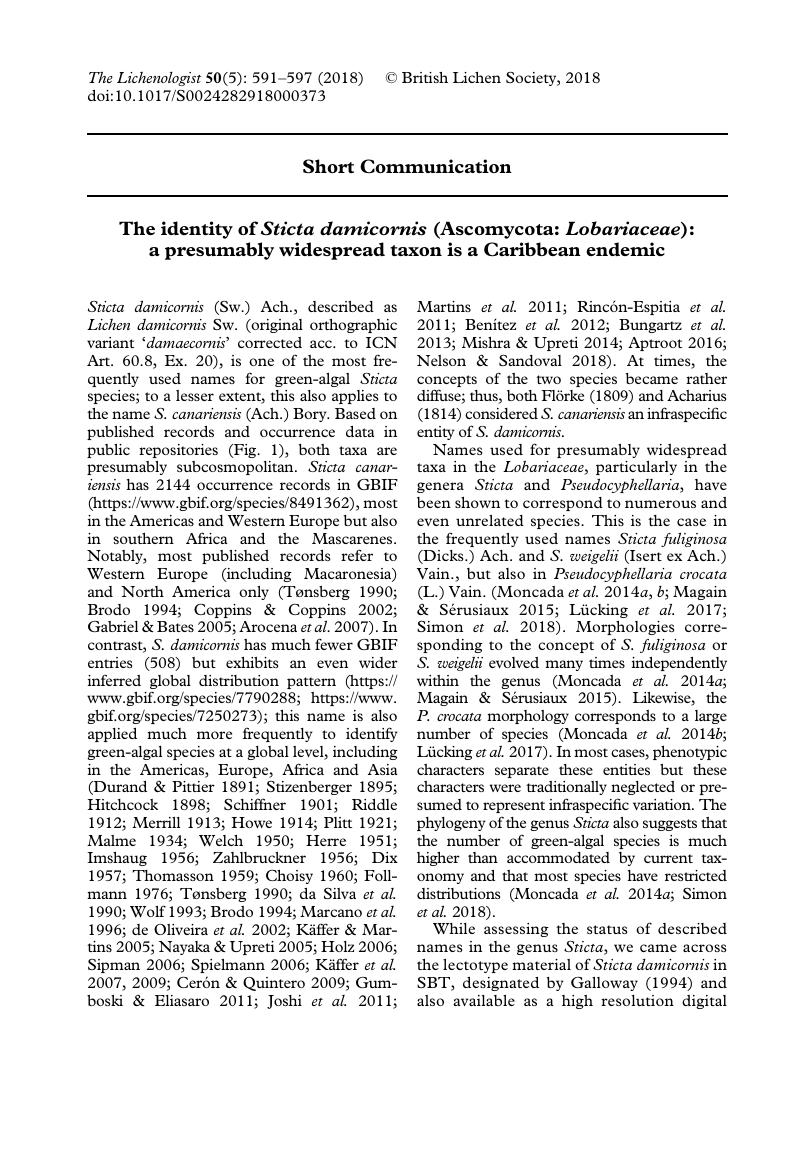Crossref Citations
This article has been cited by the following publications. This list is generated based on data provided by Crossref.
DAL FORNO, Manuela
MONCADA, Bibiana
and
LÜCKING, Robert
2018.
Sticta aongstroemii, a newly recognized species in theS. damicornismorphodeme (Lobariaceae) potentially endemic to the Atlantic Forest in Brazil.
The Lichenologist,
Vol. 50,
Issue. 6,
p.
691.
Mercado‐Díaz, Joel A.
Lücking, Robert
Moncada, Bibiana
Widhelm, Todd J.
and
Lumbsch, H. Thorsten
2020.
Elucidating species richness in lichen fungi: The genus Sticta (Ascomycota: Peltigeraceae) in Puerto Rico.
TAXON,
Vol. 69,
Issue. 5,
p.
851.
Lindgren, Hanna
Moncada, Bibiana
Lücking, Robert
Magain, Nicolas
Simon, Antoine
Goffinet, Bernard
Sérusiaux, Emmanuël
Nelsen, Matthew P.
Mercado-Díaz, Joel A.
Widhelm, Todd J.
and
Lumbsch, H. Thorsten
2020.
Cophylogenetic patterns in algal symbionts correlate with repeated symbiont switches during diversification and geographic expansion of lichen-forming fungi in the genus Sticta (Ascomycota, Peltigeraceae).
Molecular Phylogenetics and Evolution,
Vol. 150,
Issue. ,
p.
106860.
Borgato, Luca
Fryday, Alan M.
and
Ertz, Damien
2020.
Preliminary checklist of the lichens and lichenicolous fungi of Martinique, with 144 new records.
Herzogia,
Vol. 33,
Issue. 1,
p.
139.
Lücking, Robert
2021.
Peter D. Crittenden: meta-analysis of an exceptional two-decade tenure as senior editor of The Lichenologist, the flagship journal of lichenology.
The Lichenologist,
Vol. 53,
Issue. 1,
p.
3.
Moncada, Bibiana
Mercado-Díaz, Joel A.
Smith, Clifford W.
Bungartz, Frank
Sérusiaux, Emmanuël
Lumbsch, H. Thorsten
and
Lücking, Robert
2021.
Two new common, previously unrecognized species in the Sticta weigelii morphodeme (Ascomycota: Peltigeraceae).
Willdenowia,
Vol. 51,
Issue. 1,
Ossowska, Emilia Anna
Moncada, Bibiana
Kukwa, Martin
Flakus, Adam
Rodriguez-Flakus, Pamela
Olszewska, Sandra
and
Lücking, Robert
2022.
New species of Sticta (lichenised Ascomycota, lobarioid Peltigeraceae) from Bolivia suggest a high level of endemism in the Central Andes.
MycoKeys,
Vol. 92,
Issue. ,
p.
131.
Mercado-Díaz, Joel A.
Lücking, Robert
Moncada, Bibiana
St. E. Campbell, Keron C.
Delnatte, Cesar
Familia, Lemuel
Falcón-Hidalgo, Banessa
Motito-Marín, Angel
Rivera-Queralta, Yoira
Widhelm, Todd J.
and
Thorsten Lumbsch, H.
2023.
Species assemblages of insular Caribbean Sticta (lichenized Ascomycota: Peltigerales) over ecological and evolutionary time scales.
Molecular Phylogenetics and Evolution,
Vol. 186,
Issue. ,
p.
107830.
Kukwa, Martin
Rodriguez-Flakus, Pamela
Aptroot, André
and
Flakus, Adam
2023.
Two new species of Astrothelium from Sud Yungas in Bolivia and the first discovery of vegetative propagules in the family Trypetheliaceae (lichen-forming Dothideomycetes, Ascomycota).
MycoKeys,
Vol. 95,
Issue. ,
p.
83.
Ossowska, Emilia Anna
Moncada, Bibiana
Lücking, Robert
Flakus, Adam
Rodriguez-Flakus, Pamela
Olszewska, Sandra
and
Kukwa, Martin
2024.
Additional new species and new records of the genus Sticta (lichenised Ascomycota, lobarioid Peltigeraceae) from Bolivia.
MycoKeys,
Vol. 105,
Issue. ,
p.
21.





